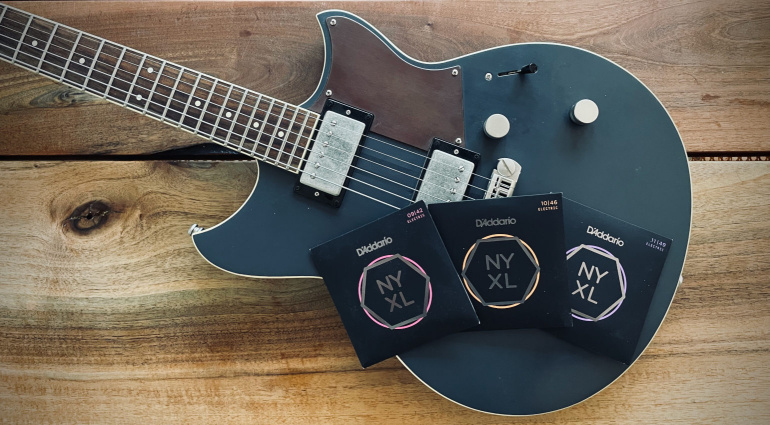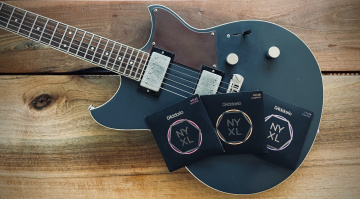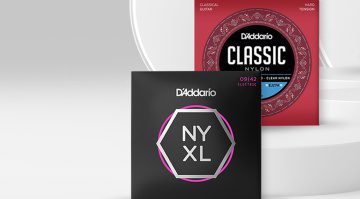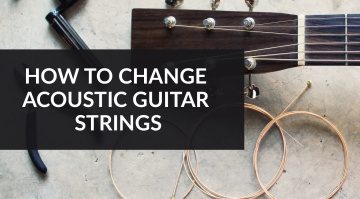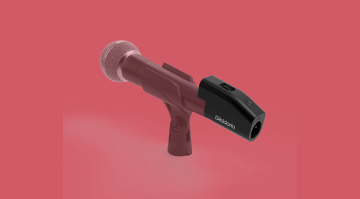D’Addario NYXL Strings Tested – Review
What are the Premium Strings Really Capable of?
For many guitarists, strings are a necessary evil. They break at the most inconvenient moments, lose their brilliance over time, and then need to be replaced. However, anyone who takes a closer look at the subject will quickly realise that good strings are much more than just wire on wood. D’Addario’s NYXL strings promise to solve almost all the problems that guitarists have faced for decades, offering greater tuning stability, longer durability and a powerful, assertive tone. Having tested three sets – in gauges 09-42, 10-46 and 11-49 – I was eager to see if the D’Addario NYXL strings would deliver on their promise.
All About D’Addario NYXL Strings
The Most Important Facts at a Glance
- High-carbon steel alloy for maximum durability
- Higher output and punch
- Measurable increase in performance between 2 kHz and 5 kHz
- Excellent workmanship
- Above-average tuning stability
Packaging & First Impression of the D’Addario NYXL Strings
Even upon unpacking, it is clear that D’Addario pays great attention to detail. The NYXL sets come in sturdy, airtight packaging that keeps the strings fresh and protects them from corrosion. A small but useful bonus is that each string is colour-coded, making it much quicker to change them – especially when you’re sitting in the semi-darkness in front of your amp and confuse the E string with the B string!
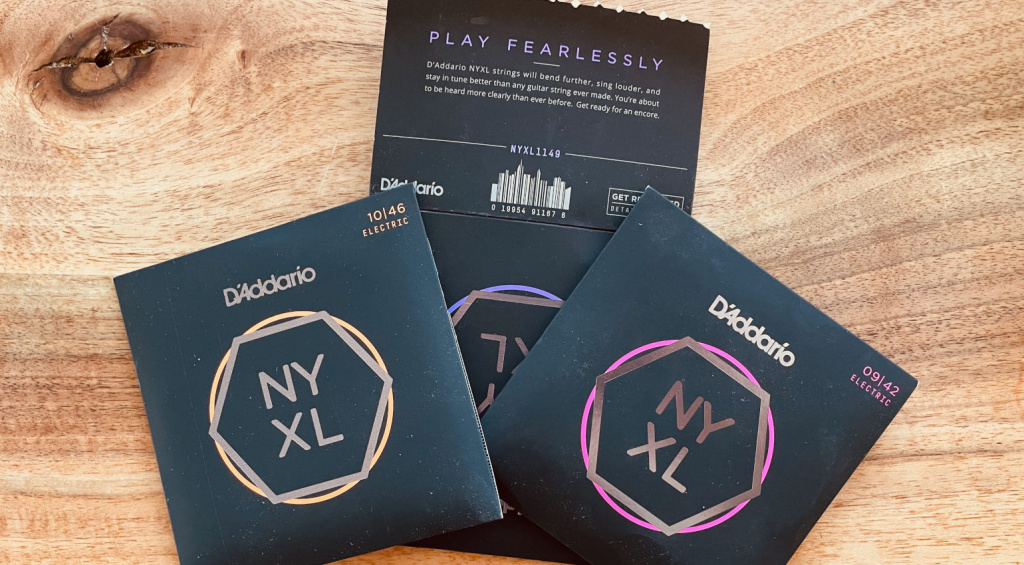
The D’Addario NYXL strings themselves are what you would expect from modern strings: smooth and evenly wound with a certain ‘freshness’ to the material that only newly strung strings have. Even when tuning for the first time, I notice that the strings seem to stretch faster than those in many standard sets. After a few minutes (and some manual stretching and exaggerated bends), the strings hold their tuning – a common frustration with new strings.
My first impression is that they are robust, modern and absolutely stage-ready. It seems as if you could use the set without hesitation in a marathon rehearsal or studio session. No sooner said than done.
Playability
String thickness is not just string thickness, and with the D’Addario NYXL strings this difference is immediately noticeable. The 09-42* set feels buttery smooth and is perfect for solo playing. Bends are almost effortless and vibrato feels controlled and pleasantly elastic. Those who prefer fast leads or intricate runs will be happy here.
For me, the 10-46* set strikes the perfect balance and will probably always be my first choice. It combines smooth handling with enough resistance to produce a rich, stable sound when playing chords. Open chords feel balanced, while power chords sound powerful and precise. This is ideal for anyone who switches between rhythm and solo parts.
Finally, the 11-49* set is aimed at guitarists who prefer a bolder, fatter sound. You can feel significantly more tension under your fingers here, and the Yamaha Revstar fitted with these strings suddenly sounds much bigger. Although extreme bendings may be challenging at first, the payoff in terms of tone is significant: fuller, more powerful and with a natural sustain that you would otherwise only expect from thick vintage strings. Bluesy licks or heavy riffs benefit from this substance – Mastodon and the late Brent Hinds spring to mind – and it’s a real alternative for anyone who likes to make their sound stand out in the mix.
Overall, I find that all three sets are exceptionally consistent and comfortable to play. There is no unpleasant scratching or unevenness; your fingers glide effortlessly over the strings. Compared to cheaper standard strings, the D’Addario NYXL seem more ‘mature’.
Overall Sound & Soundcheck
D’Addario is widely regarded as one of the biggest names on the market, and it’s no coincidence: the D’Addario NYXL strings produce a lively, fresh sound with excellent balance. Even when played unamplified, there is a noticeable clarity and distinct separation of the strings. Individual notes stand out cleanly in the room and chords remain transparent without blending into each other.
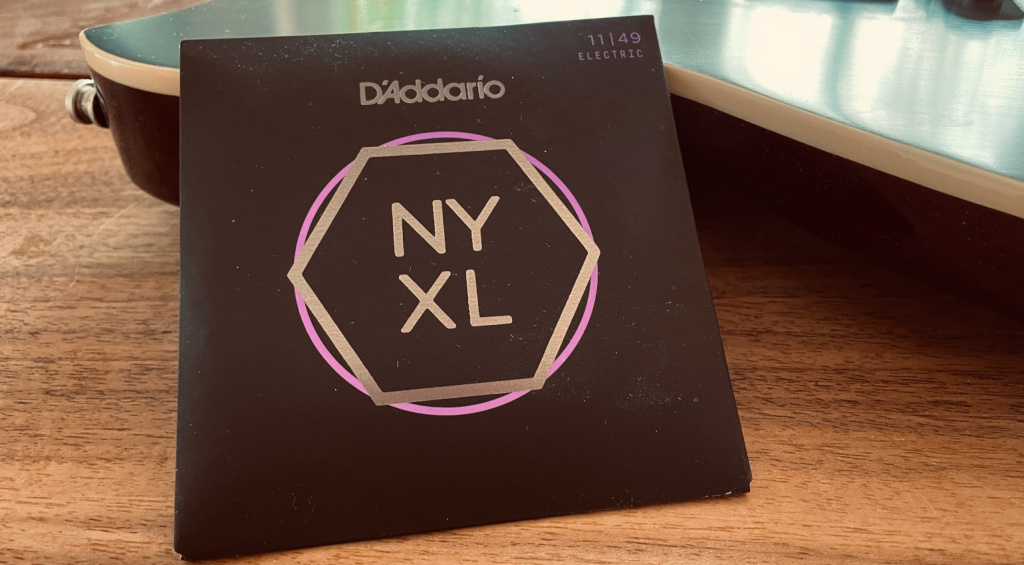
When amplified through my beloved Laney all-tube amp, the 9-string set on my old Japanese Telecaster produces crystal-clear highs with a touch of brilliance, and the 11-string set on the Revstar imparts a warm, full character to the cleans.
In the crunch range, power chords have punch and fast riffs sound defined, retaining their contour even with harder picking – as long as the right hand cooperates, of course. After all, these strings can’t work magic.
For me, the 10-gauge set strikes the perfect balance, providing enough substance for rhythmic riffing while remaining responsive enough for dynamic playing. That’s why they ended up on my favourite Paula.
Overdrive and High Gain
These two thicker D’Addario NYXL sets are great for playing with overdrive and high gain. The mids come through and the strings feel tight without muddying up, even at low tunings. The 11-gauge set in particular has a lot of punch, making it perfect for harder rock and metal parts. The 9-gauge set, on the other hand, is impressive for leads, producing a clear, singing tone. However, for fast rhythm parts à la Master of Puppets, I personally find it lacks stability.
Durability & Voice Stability
One area in which many strings quickly disappoint is their lifespan. They usually sound brilliant when freshly strung, but after a few rehearsals, they lose their shine.
This is precisely why I think there is a place for “more expensive” strings: the longer durability simply pays off, no matter how much you enjoy changing strings.
D’Addario seems to agree, as the strength of the D’Addario NYXL strings is precisely their longevity: they maintain a fresh tone for a very long time (in my opinion). Even after more than two weeks of intensive playing, they still sound crisp and clear, without that dull ‘worn-out’ quality. Visually, there’s nothing negative to report either. There’s no flaking coating, as I’ve seen with other supposedly particularly durable sets.
I particularly liked the tuning stability. Usually, new strings take a while to settle in, but with the NYXL, this process seems to happen much faster. However, I also put the strings on three guitars that I tuned for stability, so perhaps this is at least partly due to my setup.
Even in the rehearsal room and after longer sessions, the strings remain reliable. There is no noticeable ‘slack effect’ or intonation problems. In summary, the D’Addario NYXLs are ideal for continuous use, whether in the home studio, rehearsal room or during daily practice sessions—which I complete with absolute motivation.
Conclusion: Is it Worth Switching to the D’Addario NYXL?
Playing with the D’Addario NYXL strings was great fun. I’ve known these strings for a long time, but I’ve never really ‘examined’ them consciously before.
However, after testing, comparing and trying them out, it quickly became clear that a lot of innovation and energy had gone into this often overlooked product. Fresh and assertive in sound, comfortable to play and extremely stable – that’s how the D’Addario NYXL’s performance in the test can be summed up.
Their durability sets them apart from many competitors, and the short break-in period makes them particularly appealing to stage musicians. In the studio, on the other hand, they produce an impressive clarity that comes through cleanly in every mix.
They are certainly a little above average in terms of price, but given their performance, I think this is absolutely justified. If you’re willing to spend a few extra pounds, you’ll get strings that last longer, sound better and perform more reliably than many standard-grade strings.
My conclusion: A clear ‘no-brainer’ for anyone who wants to get more out of their guitar. If you’re not yet familiar with NYXLs, I urge you to give them a try!
Pros and Cons
Pros
- High-carbon steel alloy for maximum durability
- Higher output and assertiveness
- Measurable performance increase between 2 kHz and 5 kHz
- Excellent workmanship
- Above-average vocal stability
Cons
- I’ve searched long and hard, but unfortunately I can’t find any disadvantages. Sorry!
*Note: This article contains affiliate links to D’Addario NYXL strings, which help us to finance our website. Rest assured, the price remains the same for you! If you purchase an item via one of these links, we receive a small commission. Thank you for your support!

 3,6 / 5,0 |
3,6 / 5,0 | 